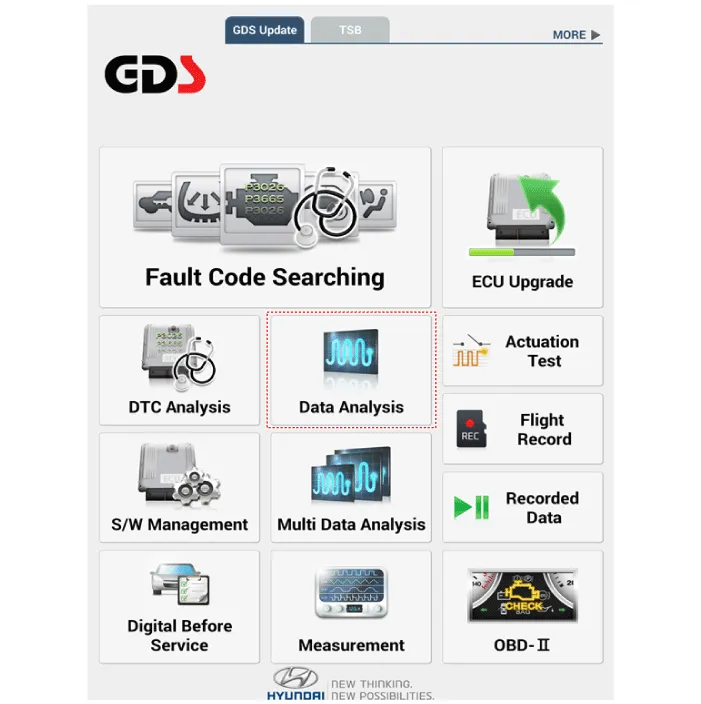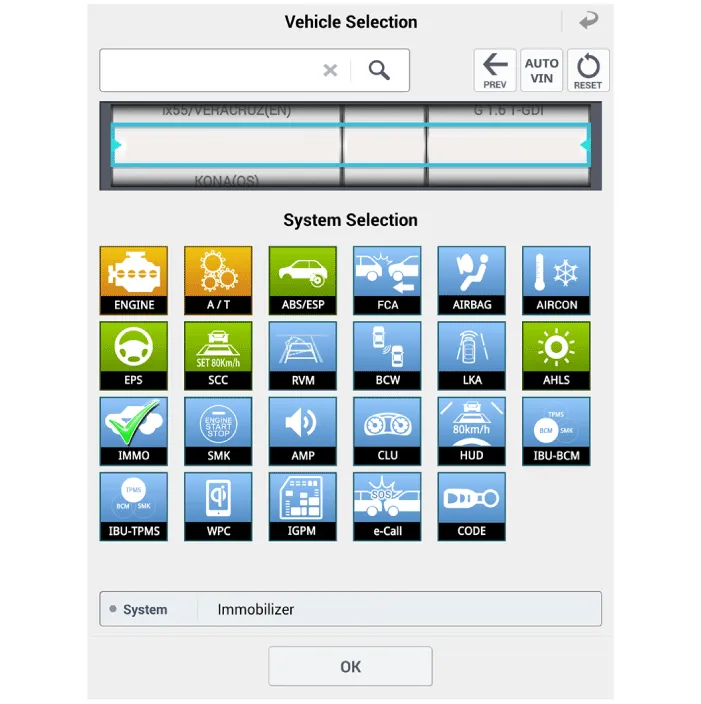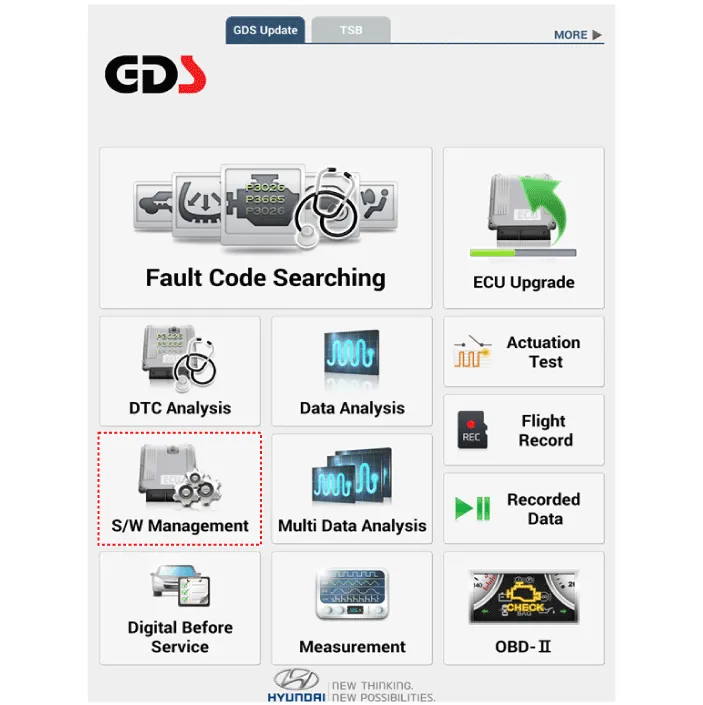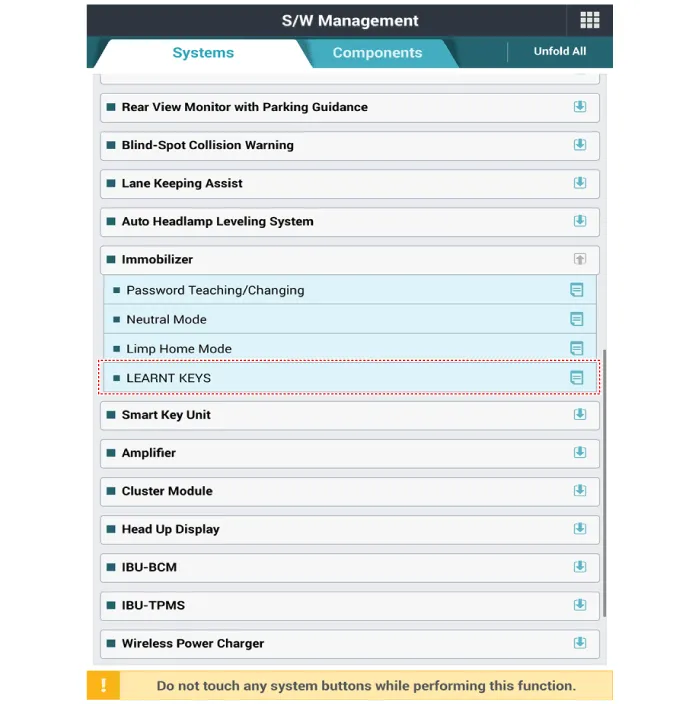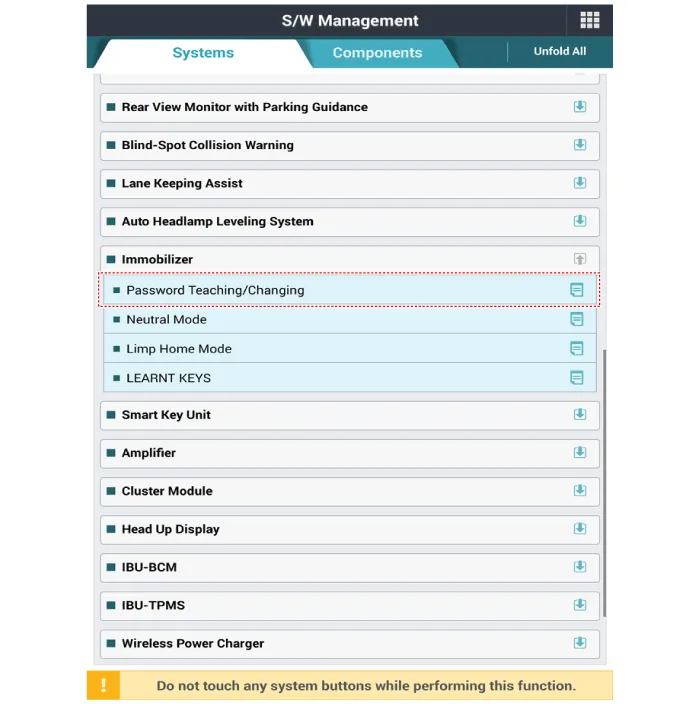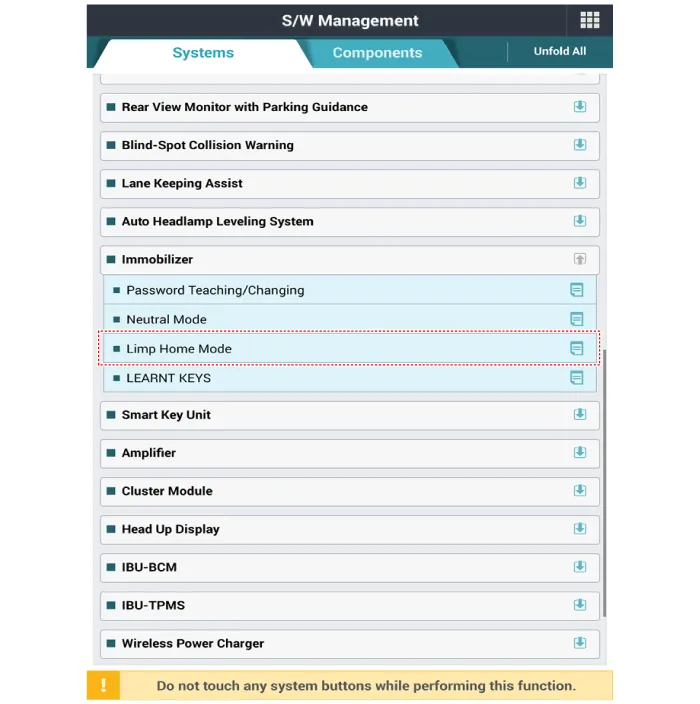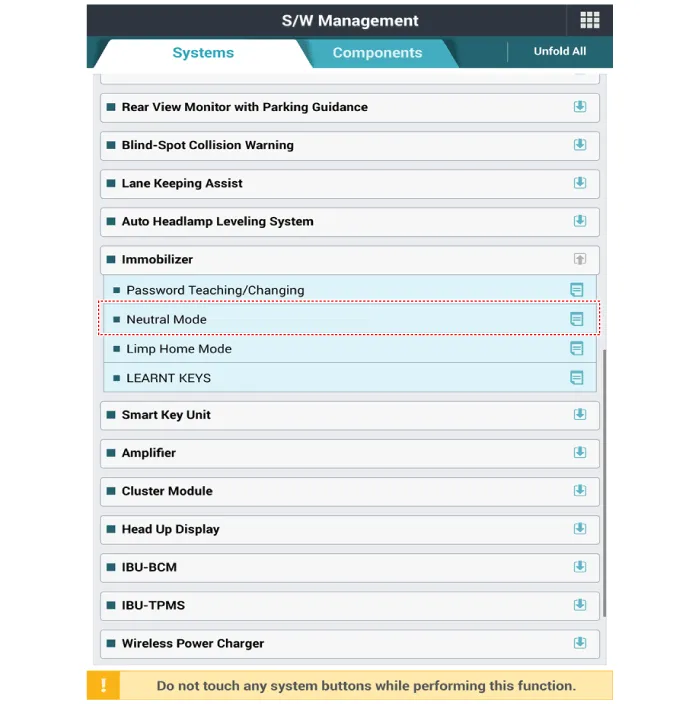Hyundai Elantra (CN7): Immobilizer System / Repair procedures
| Diagnosis with Diagnostic tool |
| 1. | In the body electrical system, failure can be quickly diagnosed by using the vehicle diagnostic system (Diagnostic tool). The diagnostic system (Diagnostic tool) provides the following information.
|
| 1. | Select the 'Data Analysis' and 'Car model'.
|
| 2. | Select the 'IMMO' to search the current state of the input/output data.
|
|

| 1. | Connect the cable of Diagnostic tool to the data link connector in driver side crash pad lower panel, and turn on the Diagnostic tool. |
| 2. | Select the 'S/W Management' and 'Car model'.
|
| 3. | Select "Imoobilizer" and "LEARNT KEYS".
|
| 4. | Perform the "LEARNT KEYS" procedure according to the Diagnostic tool screen message. |
| 1. | Connect the cable of Diagnostic tool to the data link connector in driver side crash pad lower panel, and turn on the Diagnostic tool. |
| 2. | Select the 'S/W Management' and 'Car model'.
|
| 3. | Select "Imoobilizer" and "Password Teaching / Changing".
|
| 4. | Perform the "Password Teaching / Changing" procedure according to the Diagnostic tool screen message. |
| 1. | Connect the cable of Diagnostic tool to the data link connector in driver side crash pad lower panel, and turn on the Diagnostic tool. |
| 2. | Select the 'S/W Management' and 'Car model'.
|
| 3. | Select "Imoobilizer" and "Limp Home Mode".
|
| 4. | Perform the "Limp Home Mode" procedure according to the Diagnostic tool screen message. |
|
| 1. | Connect the cable of Diagnostic tool to the data link connector in driver side crash pad lower panel, and turn on the Diagnostic tool. |
| 2. | Select the 'S/W Management' and 'Car model'.
|
| 3. | Select "Imoobilizer" and "Limp Home Mode".
|
| 4. | Perform the "Limp Home Mode" procedure according to the Diagnostic tool screen message. |
DescriptionThe immobilizer system will disable the vehicle unless the proper ignition key is used, in addition to the currently available anti-theft systems such as car alarms, the immobilizer system aims to drastically reduce the rate of auto theft.
Components and components location Components (1)With Smart KeyConnector Pin Information Pin no Connector A Connector B Connector C Connector D Connector E 1ESCL (+)_output----2Front heated nozzle_output----3-Puddle pocket lamp_output-Mirror folding_output-4Front washer switch _Input---5-LIN(PDW)--ESCL enable_output6Ground_PowerR-PDW power_input--RPM_input7Ground_ECUR-PDW power_output--Start relay_output8ESCL (-)_outputF-PDW power_output--ACC relay_output9Battery (+) ECUATM solenoid_output-Auto light sensor ground_outputStart feedback_input10Battery (+) PowerHead lamp high beam switch_input-Rear view camera switch_inputSSB switch2_input11IGN_InputFront washer switch _Input-R-PDW switch_inputTrunk antenna (-)_output12Kiline_IMMOFront wiper INT volume switch_input-P-Position_inputInterior2 antenna power(-)_output13-Wiper parking switch_input-Passenger outside handle switch_input-14-External buzzer_output-Multifunction Switch ground _InputPassenger outside handle antenna (-)_output15-R-PDW switch IND_output-ACC_input-16---IGN2_input-17--Front wiper low back up switch_input-18--Brake switch_inputDriver outside handle antenna (-)_output19---Immobilizer antenna ground_output20----21----22LIN 3(Rain sensor)-PDW option_input-23Wiper power relay_outputMirror unfolding_output-24---25Wiper low relay_output--26Wiper high relay_output-Wheel speed sensor_input27--IGN2 relay_output28Fog lamp switch_input-IGN1 relay_output29Light switch_inputAuto light sensor power_outputSSB symbol illumination(+)_output30-Auto light sensor signal_inputSSB switch1_input31-Sunroof status_inputTrunk antenna (+)_output32-ESCL unlock switch_inputInterior2 antenna power(+)_output33ESCL_COMClutch lock switch_input (MT)-34EMS ECU wake up_output/Dood unlock signal_outputDriver outside handle switch_inputPassenger outside handle antenna (+)_output 35-B-CAN High-36-B-CAN Low-37P-CAN High-38P-CAN LowDriver outside handle antenna (+)_output39-Immobilizer antenna power_output40--Without Smart KeyConnector Pin Information Pin no Connector A Connector B Connector C Connector D 1----2Front heated nozzle_output---3---Mirror folding_output4Front washer switch _Input--PDW option_input5-LIN(PDW)--6Ground_PowerR-PDW power_input--7Ground_ECUR-PDW power_output--8-F-PDW power_output--9Battery (+) ECUATM solenoid_output-Auto light sensor ground_output10Battery (+) PowerHead lamp high beam switch_input-Rear view camera switch_input11IGN_InputFront washer switch _Input-R-PDW switch_input12Kiline_IMMOFront wiper INT volume switch_input-P-Position_input13-Wiper parking switch_input--14---Multifunction Switch ground _Input15-R-PDW switch IND_output-ACC_input16---IGN2_input17--Front wiper low back up switch_input18--Brake switch_input19---20---21---22LIN 3(Rain sensor)--23Wiper power relay_outputMirror unfolding_output24--25Wiper low relay_outputB-CAN High26Wiper high relay_outputB-CAN Low27-P-CAN High28Fog lamp switch_inputP-CAN Low29Light switch_inputAuto light sensor power_output30-Auto light sensor signal_input31-Sunroof status_input32-Key solenoid_output33Key hall illumination_outputStart inhibit relay_output34EMS ECU wake up_output/Dood unlock signal_outputkey in switch_input35--36--37Immobilizer antenna power_output38Immobilizer antenna ground_output39-40- Repair procedures Removal1.
Other information:
Hyundai Elantra (CN7) 2021-2025 Service Manual: Troubleshooting
TroubleshootingProblem Symptoms TableBefore replacing or repairing air conditioning components, first determine if the malfunction is due to the refrigerant charge, air flow or compressor.Use the table below to help you find the cause of the problem. The numbers indicate the priority of the likely cause of the problem.
Hyundai Elantra (CN7) 2021-2025 Service Manual: PM Sensor
Description and operation DiscriptionMonitor the air quality inside the vehicle in real time (PM sensor) and display the status on the screen.Automatically operate when fine dust concentration is high (Condition: Bet mode + A/C ON + 3rd speed or higher) Components and components location Components Location1.
Categories
- Manuals Home
- Hyundai Elantra Owners Manual
- Hyundai Elantra Service Manual
- Heating, Ventilation and Air Conditioning
- Suspension System
- Engine Electrical System
- New on site
- Most important about car

